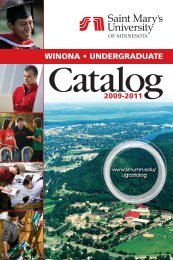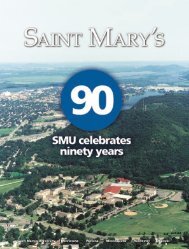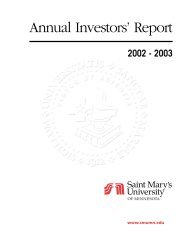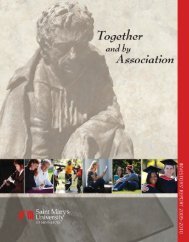& Student Handbook - Saint Mary's University of Minnesota
& Student Handbook - Saint Mary's University of Minnesota
& Student Handbook - Saint Mary's University of Minnesota
You also want an ePaper? Increase the reach of your titles
YUMPU automatically turns print PDFs into web optimized ePapers that Google loves.
Master Degree Programs 149<br />
RA651<br />
Spatial Analysis <strong>of</strong> Geohazards Using GIS (1 cr.)<br />
Prerequisites: RA660<br />
Geologic hazards loom all around. As population growth forces more<br />
communities to expand into areas at risk, concern increases about the<br />
danger that geohazards pose to people, property, and the environment.<br />
This course shows how GIS can be used to determine where<br />
geohazards are likely to occur and assess their potential impact on the<br />
human community. Participants work with GIS s<strong>of</strong>tware to analyze and<br />
map a variety <strong>of</strong> geohazards. A better understanding <strong>of</strong> these events is<br />
the first step toward effective disaster planning.<br />
RA653<br />
Natural Resource Risk Assessment and Management (1 cr.)<br />
Prerequisites: RA660<br />
As population growth forces more communities to expand into areas at<br />
risk, concern increases about the danger that geohazards pose to<br />
people, property, and the environment. HAZUS-MH is a powerful, free<br />
ArcGIS extension developed by the Federal Emergency Management<br />
Agency (FEMA) under contract with the National Institute <strong>of</strong> Building<br />
Sciences. HAZUS-MH works with ArcGIS Desktop to display hazard<br />
data and estimate the impact <strong>of</strong> hurricanes, floods, and earthquakes on<br />
communities (e.g., damage to buildings and lifelines, estimates <strong>of</strong><br />
displaced populations and shelter needs, and short- and long-term<br />
economic impacts). In a course project, students apply the skills they’ve<br />
learned throughout the course.<br />
RA654<br />
Introduction to Urban and Regional Planning (1 cr.)<br />
Prerequisites: RA660<br />
For decades, urban and regional planners have used GIS technology<br />
to help find solutions to the challenges posed by increasing population<br />
growth and urban development. This course covers basic urban and<br />
regional planning concepts and tasks and teaches how those tasks can<br />
be managed using GIS techniques and ArcGIS Desktop s<strong>of</strong>tware.<br />
<strong>Student</strong>s learn how to use ArcGIS tools to address real-world social,<br />
economic, and environmental planning problems. The skills and<br />
techniques presented in the course provide an effective and efficient<br />
means <strong>of</strong> carrying out urban and regional planning tasks.<br />
RA655<br />
Creating and Integrating Data for Natural Resource<br />
Applications (1 cr.)<br />
Prerequisites: RA660<br />
Frequently, the natural resource data needed for a project (such as<br />
vegetation, species locations, or watersheds) does not exist. Or, the data<br />
may exist but significant manipulation is required before it can be<br />
displayed and used for analysis in a GIS. This four-module course<br />
teaches methods for acquiring, evaluating, creating, manipulating, and<br />
integrating data in preparation for analysis and map creation. <strong>Student</strong>s<br />
learn tips for assembling a high-quality database, as well as best<br />
practice approaches to data problems commonly encountered by those<br />
in the natural resource and conservation fields. In a course project,<br />
students apply the skills they've learned throughout the course.<br />
Elective GIS Courses<br />
RA506<br />
GIS Customization (3 cr.)<br />
Prerequisites: RA554, RA632 and RA660<br />
This course focuses on customization <strong>of</strong> a GIS through programming<br />
and scripting languages utilizing VBA (Visual Basic for Applications).<br />
Emphasis <strong>of</strong> the course is on customization <strong>of</strong> the ArcGIS s<strong>of</strong>tware<br />
including modifications <strong>of</strong> the user interface, and building custom<br />
applications through use <strong>of</strong> the ESRI COM object library.<br />
RA559<br />
Introduction to Imagery (3 cr.)<br />
This course introduces the use <strong>of</strong> imagery to resource analysis. It covers<br />
working with aerial photographs, interpreting photos, optical rectification<br />
and zoom transfer. It also examines major satellites in use, acquiring<br />
available imagery and working with those images.<br />
RA560<br />
ArcView (1 cr.)<br />
This course introduces students to the functionality and applications <strong>of</strong><br />
the ArcView desktop GIS system. Included are how to access data from<br />
ArcInfo for use, conduct queries, and analysis <strong>of</strong> data, prepare simple<br />
and complex graphical analyses and presentations integrating maps.<br />
Additionally, learners complete a demographic data analysis using<br />
ArcView.<br />
RA570<br />
Advanced GIS (3 cr.)<br />
Prerequisites: RA554 and RA660<br />
This course builds upon RA554 and emphasizes spatial analysis,<br />
modeling and advanced presentation techniques. Substantial effort is<br />
directed towards developing pr<strong>of</strong>iciency with raster cell analysis, as well<br />
as integration <strong>of</strong> analyses utilizing both vector and raster elements<br />
simultaneously. Advanced presentation techniques involving 3-D<br />
modeling, analytical view shading and more are included. Emphasis is<br />
on the ArcGIS 9.x ArcMap environment.<br />
RA<br />
Directed Studies (1 cr.)<br />
This independent study course is designed to engage students in the<br />
instructor mentored environment. In this instance, the student, mentored<br />
by a university instructor, is encouraged to explore GIS and computermapping<br />
applications in the area <strong>of</strong> his/her interest.The course<br />
culminates in a written paper and a seminar presented to students <strong>of</strong> the<br />
university.<br />
Admission Requirements<br />
Applicants may apply for admission to master degree programs at any<br />
time during the year. Applicants must have completed an undergraduate<br />
degree from a regionally accredited institution and maintained an overall<br />
grade point average <strong>of</strong> 2.75 on a 4.00 scale. Applicants must<br />
demonstrate the language pr<strong>of</strong>iciency necessary for successful graduate<br />
coursework. If the grade point average upon admission is below 2.75, or<br />
if a grade point average is not available, or language pr<strong>of</strong>iciency is not<br />
adequate, the applicant may be admitted with provisional status.
















